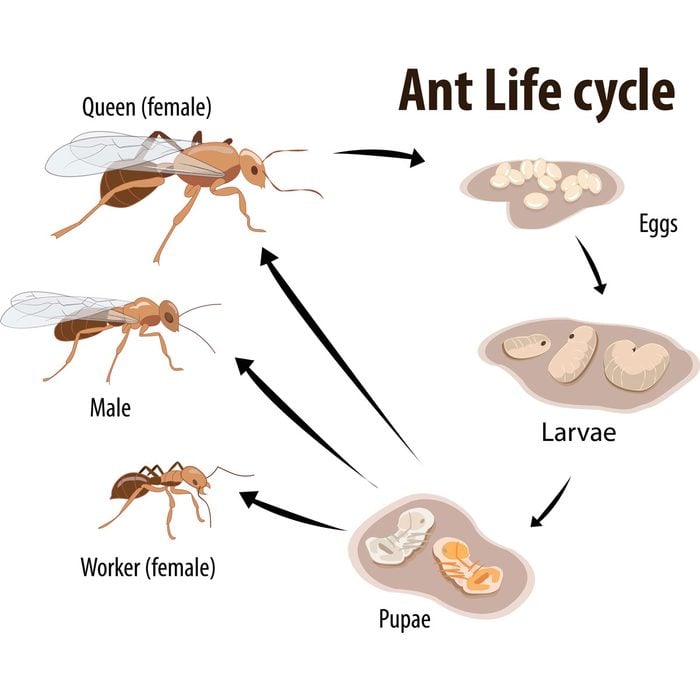What to Know About an Ant’s Life Cycle

Discover what an ant's life cycle is like to understand how to identify and combat these household pests.
An ancient species, ants have roamed the Earth for billions of years. Wholly reliant on their evolved social structure (colonies) for survival, ants are fascinating and complex creatures. They can also be a formidable pest, infesting homes, yards and gardens with fervor.
On This Page
The Ant Life Cycle
Like other social insects (i.e., bees, wasps and hornets), ants undergo a metamorphosis in four life stages: egg, larvae, pupae and adult. The entire process can take up to 60 days from start to finish.
We explore an ant’s cycle of life, from how they reproduce to ways they function in their community. Knowing the facts about an ant’s life cycle may prove helpful in combating an ant infestation more effectively, should you encounter one.
Egg stage
White and glistening, the tiny egg is where an ant’s life begins. Fertilized eggs beget females, and unfertilized eggs males. Did you know that the queen leafcutter ant produces some 150 million workers in her lifetime, and an army ant can lay up to 300,000 eggs in a single day? Respect!
Larvae stage
At this stage of an ant’s development, the egg transforms into larvae. In constant need of nourishment, a single larva grows so rapidly that it molts (sheds its skin) several times during this phase, which lasts between seven and 14 days.
Pupae stage
In this third and final gestation period (six to 10 weeks) the pupae of some species spin protective cocoons, while others remain uncovered.
Adult stage
Once the adult surfaces from a pupa, it’s fully formed and ready to go. Because the queen can churn out thousands of worker ants, the best way to eliminate a colony is to kill the queen where she lives and breeds.
The Difference Between Adult Male and Female Ants
Queen
Every ant colony has at least one queen. Some species, such as the Argentine ant, may have two or more.
Significantly larger than her compatriots, a queen will lay eggs that hatch into new queens with wings that they use to fly out of the nest to mate (queens are the only females able to reproduce). Once a new queen locates a spot to nest, she lays her eggs, then feeds and grooms the hatched larvae until they turn into cocoons (or remain uncovered depending on the species). In a few weeks, new adult workers emerge and the colony is officially up and running.
Drones
Drones are fertile, winged males whose only function is to impregnate a queen. Once the deed is done, it’s curtains for the male, who dies usually within a few weeks.
Workers
Of the castes in the colony, the multi-tasking workers (sterile females) are the most numerous. They perform such essential duties as foraging for food, burrowing tunnels, warehousing food and tending to the larvae. Workers and soldiers (larger workers who defend nests) can survive as long as seven years.
The Lifespan of an Ant
The average lifespan of an ant can be anywhere from a few weeks to 15 years. That depends on the species, the role the ant plays and the availability of food sources. For instance, a black garden ant can live almost two decades, while fire ant workers are expected to live less than a month.
Long live the queen! In almost every species, her royalness outlives everyone else in the colony. Some queens are believed to have reigned for 28 years!



